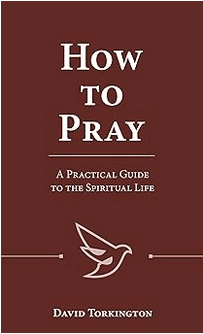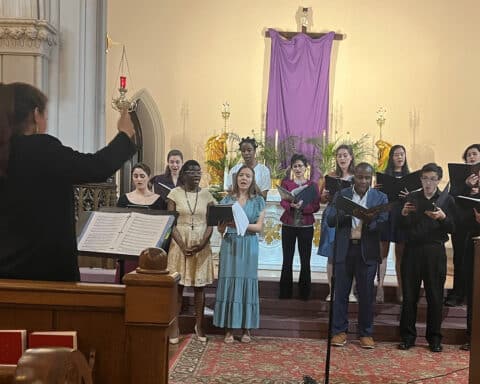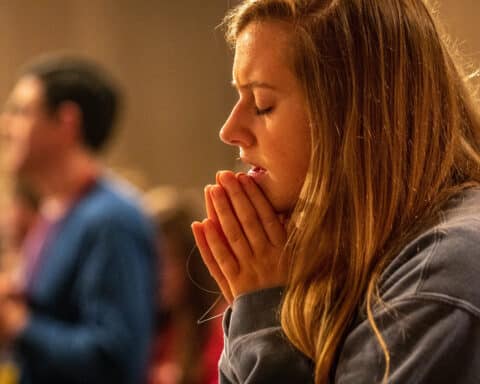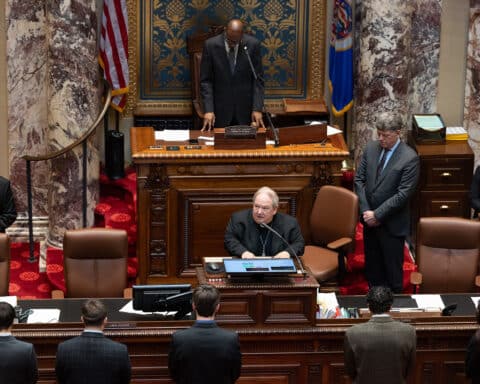“The mystical capacity of the human mind needs to be strengthened again. The capacity to renounce oneself, a greater inner openness, the discipline to withdraw ourselves from noise and from all that presses on our attention, should once more be for all of us goals that we recognize as being among our priorities.”
Joseph Ratzinger wrote that. It is all the more powerful realizing how dramatically he did that. I remember the day he announced that he would be walking away from the papacy. People were shocked and jarred. Maybe it was a grace that I wasn’t — to be able to do media that day — but I just kept thinking: The pope has let us in on his prayer life. He believed the Holy Spirit had something even more important than the papacy. Prayer is that powerful. Prayer matters that much. The Church and the world needed prayer, and he was dedicating himself to it in a new way.
Father Donald Haggerty is a priest on staff at St. Patrick’s Cathedral. In pre-COVID days, young Catholic staff at National Review would report back to me that they had hit the spiritual jackpot when they wound up at daily Mass with him. The priests of the Archdiocese of New York tell me he is called “Don of the Cross,” which is fitting. He has a knack for leading a little bit of a contemplative retreat even on a busy weekday on Fifth Avenue, with tourists and shoppers and everyone else walking around the cathedral. In recent days, the cathedral has made news for other things, but this is the stuff of non-headlines and actual renewal in the Church and the lives of those who encounter Jesus because of it.
I remember one day — it might have been a Friday in June — when Father Haggerty spoke about the Sacred Heart of Jesus in a homily. When we contemplate the Sacred Heart of Jesus, our hearts change, he said. We want to have his heart. We want to be changed. We want to love with his heart. It’s something real. Something we can’t teach so much as show. The most effective preacher radiates love from his heart. And we then better understand our thirst for him and, even more remarkably, his thirst for us.
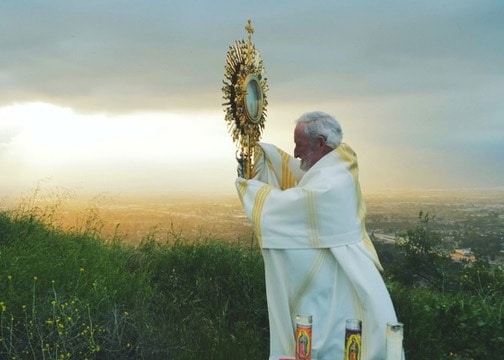
Becoming mystics
A little over a year ago, Los Angeles Auxiliary Bishop David O’Connell was murdered. He ministered to everyone from violent criminals to innocent children in the worst of circumstances. I was with him in Lourdes once, and I saw how Our Lady had a special love for him. She has such a love for all of us if we let her. We don’t always. Bishop O’Connell was insistent that everyone can come to a deeper love of Jesus by saying his name in our hearts. He would teach this to gang-member criminals and to children who had seen too much suffering already in life. Say Jesus’ name. Know his presence. It’s more real than most of what the culture has us pay attention to.
How many children try to escape life? It’s probably good news if it is video games. It could be drugs and crime. What if they could know the life of the Lord within them? What if they could know the Trinity?
It’s so hard to quiet ourselves in the world today. Ignatian prayer has taught me over the years to acknowledge the presence of God the Father, and of Jesus, and of the Holy Spirit before I even begin to pray. In a time of an epidemic of loneliness, that makes all the difference. And for a child who maybe has never known a father in this world, it could be a gamechanger not just for prayer, but for life. I confess I was skeptical, but Bishop O’Connell insisted he had seen miracles by that simple prayer of the heart to know the presence of Jesus.
“What we need to do is teach our people how to be mystics,” Bishop O’Connell told me shortly after we got back from Lourdes in the fall of 2017. “We have to teach our children how to be mystics. Mystics are ones who are entering into a deep, deep loving relationship with Jesus, and it’s a real relationship. It’s a healing, life-changing relationship. It’s a great gift we can give them.”
Children as mystics? That’s not a commonplace thought. And yet, who better to show us the way? Children, unless they have been too abused by wounded adults succumbed by evil, tend not to be as cynical as the rest of us. They can show us the possibilities for knowing Jesus and loving Jesus and showing Jesus. If we are pure and loving enough to open a door.
Living a contemplative life
In his book, “The Contemplative Hunger,” Father Haggerty has a chapter that headlines a question. “A Contemplative Revolution?” He asks it, but he is big-time proposing it. Because he knows it’s what we need — following the lead of Cardinal Ratzinger and Bishop O’Connell (and many contemplative saints who have led by example).
“Contemplative life is a mystery of grace,” Father Haggerty writes:
“It is a response to a profound attraction to God drawing a soul to seek God in prayer. For many lives, it is a great love of their life to carve our reserved time for God in daily silent prayer. At the same time, contemplative life is never a personal pursuit alone. It has always a relationship with the larger struggle of Christian belief in the contemporary world. The evidence is strong today that a desire for silent prayer is being felt by more and more souls, a phenomenon most notable for taking place outside cloisters and monasteries. It is a spiritual sign of the times. This leaning in attraction toward more intensive prayer within the Church may reflect a reaction to the growing indifference to God in the larger world. Perhaps only those who commit themselves more fully to prayer can realize the connection. The quiet hunger for deeper prayer may in fact be the most vital deterrent to the increasing tide of secularization in the current world.”
About once a month I’m on a Zoom call with people who are seeking just this. A Dominican priest reflects on how to cast away distractions to know our lives in the Trinity. It’s a bit of a luxury to have the calendar invite, and yet it is what we are called to, with or without Zoom.
A few years ago, Gary Jansen wrote a book pointing out that 15 minutes is 1% of the day. So he proposed a “15-Minute Prayer Solution.” If you want to spend more time with God, start there. Writing the introduction of another book of his — an Ignatian meditation on the Stations of the Cross for Lent (“Station to Station”) — our mutual friend and convert Jennifer Fulwiler described her first time meeting him, realizing he was a mystic. I gave my mother that book when it came out, and she was surprised to learn I knew a mystic. Put aside what that says about what I’ve witnessed to my mom about my prayer life for a moment. Being a mystic shouldn’t be exotic. And yet, it tends to be. And apparently because of how I live my life! Such reactions should be a challenge to us all. And, yes, we can start with 15 minutes.
“The quiet hunger for deeper prayer may in fact be the most vital deterrent to the increasing tide of secularization in the current world.”
Father Donald Haggerty
I was out of my normal circumstances recently, visiting with friends from college. One is a priest. One is a mother. The priest was in vacation mode. I was trying to work while visiting. Monsignor insisted on a daily holy hour after Mass. Honestly, I thought I was too busy. I think that’s when you know you should do not one but two hours! I announced the first day that I would probably fall asleep, because stress had me not sleeping. He seemed surprised and disappointed but received me as I was.
When the time came, I wept in front of Jesus. What love he has for us. What humility he draws out of us in the depths of his love for us, appearing as he does in the Eucharist for us. I couldn’t sleep during that hour. I could only be thankful and want Jesus all the more to inundate my life with his love so I might actually live the Beatitudes. What if we lived the Beatitudes? So much would be so different. Why don’t we try? We try by starting with those 15 minutes and that holy hour and whispering to Jesus and Mary throughout the day for the grace to be the authentic Christians we were baptized to be.
Making the time for prayer
In late 2012, I was at a conference at the Vatican and was unexpectedly admonished (we all were) by Pope Benedict, right before he resigned. It was a gathering reflecting on John Paul II’s encyclical Ecclesia in America, and there were Catholic leaders from North and South America. He told us that if we were not encountering Jesus in prayer and Mass daily, none of our evangelical plans were worth anything. This was a time when many were talking about the New Evangelization. Never mind about that if you are not praying, he said. It was a wake-up call. All too often if you are doing Catholic work during the day, it can seem like you are praying. It is true that you can offer up your work, whatever it is, as a prayer. Mothers of young children often have to. When is there time for quiet prayer outside the shower? And yet, isn’t there a longing? If there isn’t, our souls may need resuscitation.
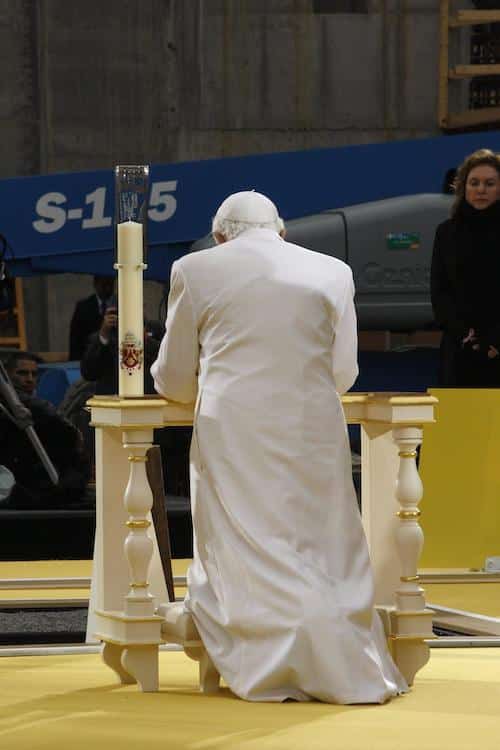
“Dear friends, the love of Christ impels us to devote ourselves without reserve to proclaiming his Name throughout America, bringing it freely and enthusiastically to the hearts of all its inhabitants,” Pope Benedict said to us that day in St. Peter’s Basilica. He continued:
“There is no more rewarding or beneficial work than this. There is no greater service that we can provide to our brothers and sisters. They are thirsting for God. For this reason, we ought to take up this commitment with conviction and joyful dedication, encouraging priests, deacons, consecrated men and women and pastoral agents to purify and strengthen their interior lives ever more fully through a sincere relationship with the Lord and a worthy and frequent reception of the sacraments. This will be encouraged by suitable catechesis and a correct and ongoing doctrinal formation marked by complete fidelity to the word of God and the Church’s Magisterium and aimed at offering a response to the deepest questions and aspirations of the human heart. The witness of your faith will thus be more eloquent and incisive, and you will grow in unity in the fulfillment of your apostolate. A renewed missionary spirit and zealous generosity in your commitment will be an irreplaceable contribution to what the universal Church expects and needs from the Church in America.”
“Dear friends, the love of Christ impels us to devote ourselves without reserve to proclaiming his Name throughout America, bringing it freely and enthusiastically to the hearts of all its inhabitants.”
Pope Benedict XVI
Is there the contemplative hunger? Is there the thirst? Do we know it and feel it and acknowledge it? I know I feel it when I make the time. But will we make the time?
‘Do-ers’ also need prayer
In his “Contemplative Hunger,” Father Haggerty writes:
“Can a ‘contemplative revolution’ take place in the Church? A significant turn among many souls to the fundamental importance of silent prayer in hours alone before the gaze of God? Surely spiritual upheavals do happen at certain periods in the Church’s history. But in this case it would primarily mean a concealed action undertaken by large numbers of hidden souls in quiet corners of the Church, yet fruitful in ways that cannot be evaluated so easily. Unlike reforms that are more public and visible, this one is unlikely to show dramatic effects or influences so immediate. The repercussions of contemplative life occur in the mysterious realm of hidden graces and usually take time. Nonetheless, the contemplative lives in any era are a great flame burning beneath the endeavors of the Church. This influence does not just come from the contemplatives praying in cloisters and monasteries. Souls of contemplation who gives themselves in apostolic works plant seeds of spiritual hunger in many souls around them. An encounter with them is often the beginning of a profound need to find God personally in love of prayer.”
And the key for their ability to serve is because of their time with God in prayer. A few years ago, when I put together a book “A Year with the Mystics: Visionary Wisdom for Daily Living,” I made sure to not just include John of the Cross and Teresa of Avila — people we associate with reaching the spiritual heights during their lives here on earth. I included people we think of as do-ers. There’s a movie out right now about Mother Cabrini. She’s in there. She couldn’t have helped the orphans without her prayer life. Same with Mother Teresa and Elizabeth Ann Seton and John Paul II. You get the idea. Prayer fuels loving service.
A new Pentecost
This contemplative revolution Father Haggerty proposes is a gaping need right now. I’ve been accused — fairly — of making everything about abortion. (Having spent a little too much time outside an abortion clinic praying and counseling, I have been known to bring the topic up earlier in the morning than is polite.) It’s more, though, about the Catholic understanding of the human person that we’ve lost in the wake of the sexual revolution. So many people don’t see their own value, their own dignity — how God cherishes them. I’ve spent some time around the Sisters of Life, whose charism includes the protection of human life, as the name suggests. Celebrating birthdays is a big thing for them, because they’ve seen how many women who come to them have never had their birthday celebrated. Think about that. You’re pregnant in un-ideal and probably desperate circumstances. And no one has ever had a birthday party for you. How can you receive this new life if no one has ever celebrated your life? That’s a simple, practical thing. But when we realize how deeply people are hurting, we must fall on our knees and beg God to both let women and men know they are loved and ask for the grace to love them with the heart of Jesus.
Back on Fifth Avenue in New York, Pope Benedict made a visit in 2008. In his homily at Mass, he implored a new Pentecost. He said, in part:
“This is no easy task in a world which can tend to look at the Church, like those stained glass windows, ‘from the outside’: a world which deeply senses a need for spirituality, yet finds it difficult to ‘enter into’ the mystery of the Church. Even for those of us within, the light of faith can be dimmed by routine, and the splendor of the Church obscured by the sins and weaknesses of her members. It can be dimmed too, by the obstacles encountered in a society which sometimes seems to have forgotten God and to resent even the most elementary demands of Christian morality. You, who have devoted your lives to bearing witness to the love of Christ and the building up of his Body, know from your daily contact with the world around us how tempting it is at times to give way to frustration, disappointment and even pessimism about the future. In a word, it is not always easy to see the light of the Spirit all about us, the splendor of the Risen Lord illuminating our lives and instilling renewed hope in his victory over the world.
“Yet the word of God reminds us that, in faith, we see the heavens opened, and the grace of the Holy Spirit lighting up the Church and bringing sure hope to our world. ‘O Lord, my God,’ the Psalmist sings, ‘when you send forth your spirit, they are created, and you renew the face of the earth.’ These words evoke the first creation, when the Spirit of God hovered over the deep. And they look forward to the new creation, at Pentecost, when the Holy Spirit descended upon the Apostles and established the Church as the first fruits of a redeemed humanity. These words summon us to ever deeper faith in God’s infinite power to transform every human situation, to create life from death, and to light up even the darkest night. And they make us think of another magnificent phrase of Saint Irenaeus: ‘where the Church is, there is the Spirit of God; where the Spirit of God is, there is the Church and all grace.'”
| Further Reading |
|---|
|
“How to Pray: A Practical Guide to the Spiritual Life” (OSV, $12.95) by David Torkington In “How to Pray: A Practical Guide to the Spiritual Life,” theologian David Torkington offers everyday guidance for entering more deeply into prayer, whether you are a beginner or looking to go deeper in your prayer life. The 40 short, easy-to-read chapters in this guide can be read as a devotional, for meditation, or alongside Sacred Scripture. |
The one road
Sometimes I walk from the cathedral — which has been in the news recently for non- contemplative matters — and wonder if that new Pentecost is possible. The thought usually draws me into offering an incomplete and imperfect Rosary. But as I once heard Father Haggerty say at St. Patrick’s, those are Hail Marys prayed that wouldn’t otherwise have been. The truth is, in other parts of the world, people are living on a prayer, as Bon Jovi might put it. They might not know New Jersey, but they know the Holy Spirit. Nigerians who go to Mass knowing they might be putting their lives on the line for doing so. Young men there become priests even though they watch as seminarians and priests are kidnapped and killed. They know what life is about: It’s about God and eternity. They are not distracted in so many ways we are. We don’t have the large number of vocations to the priesthood that they do. Is it because we are not praying? Is it because we don’t believe like they do? Do we hunger for something different? For something more? For actually living the Gospel in the world today both within the cathedral and beyond those stained-glass windows? It’s the only way we are going to show the love of God to a hurting world.
Consider yourself a chalice. You must let Jesus fill you with himself. After a time of prayer, consider yourself a monstrance, to show him to the world.
“There is but one road which reaches God, and that is prayer; if anyone shows you another, you are being deceived.”
St. Teresa of Avila
Father Haggerty has written several books on the spiritual life. I usually gift people his book on conversion first. It’s not so much about Saul becoming Paul but about the continual conversion we are called to on our life’s journey to union with God (which is what mysticism is). In the “Contemplative Hunger,” Father Haggerty writes: “Contemplative life, even in its concealed quality, may be the most powerful adversary to the tides of secularization undermining religious belief in the modern time. Yet few people even of serious religious temperament realize this.” We try to argue and fix and come up with strategies. But how about going to God? At that conference at the Vatican on Ecclesia in America, I wound up presenting briefly in Paul VI Hall about a discussion on marriage and family some of us had. Almost to a person, participants testified that whatever their ministries with young people and couples, nothing they could come up with was as successful as time in Eucharistic adoration. That was long before the U.S. bishops proposed a Eucharistic Revival like we’re having right now. Because spending time before Jesus is nothing new, yet it’s not as often tried as it ought to be.
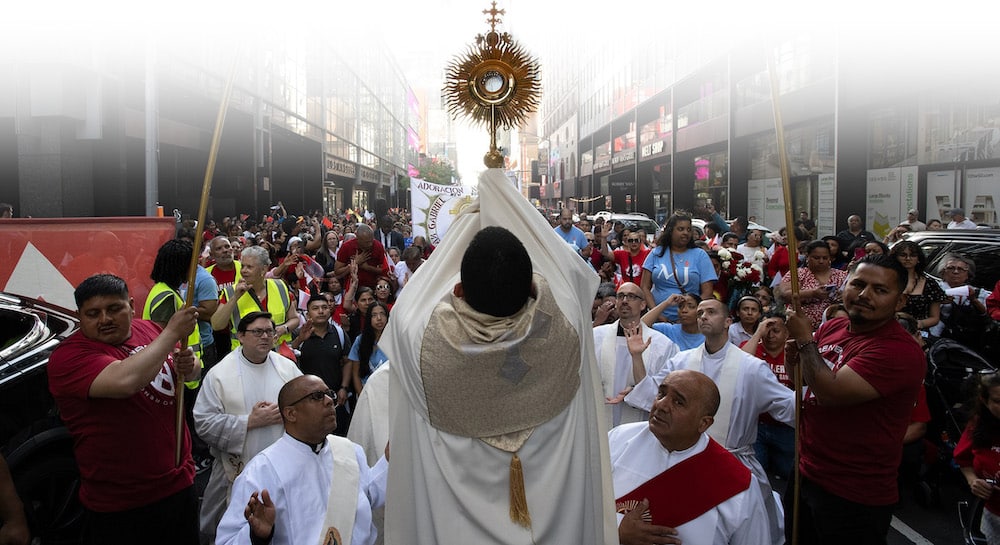
In the opening of his “A Contemplative Revolution?” proposal chapter, Father Haggerty quotes Doctor of the Church, tried and true contemplative St. Teresa of Avila: “There is but one road which reaches God, and that is prayer; if anyone shows you another, you are being deceived.” Shall we get to it?
Pray for that new Pentecost. Come, Holy Spirit!



